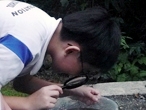Why Singapore’s English Teachers Should Embrace Singlish, Not Fight It
Is it time for Singaporean educators to embrace Singlish as a legitimate learning tool? What the Research […]
Read More
Acting and singing are not what you typically see in a Science class. But that’s exactly what took place at a recent nature symposium for students.
Guided by their teachers, students from four schools – Boon Lay Garden Primary, Corporation Primary, Marsiling Primary and Methodist Girls’ School – had attended a one-day Nature Learning Camp (NLC) last year. The students then conducted investigations into scientific phenomena at Upper Seletar Reservoir from June to November last year, and presented their findings at the symposium this year.
 Members of the Natural Sciences and Science Education and Learning Sciences and Technologies academic groups at the National Institute of Education came together to study how students can build on their scientific knowledge. Assistant Professor Lee Yew Jin and Dr Jennifer Yeo tell us about their research project, Making Meaning of Environmental Science through Computer-supported Collaborative Learning.
Members of the Natural Sciences and Science Education and Learning Sciences and Technologies academic groups at the National Institute of Education came together to study how students can build on their scientific knowledge. Assistant Professor Lee Yew Jin and Dr Jennifer Yeo tell us about their research project, Making Meaning of Environmental Science through Computer-supported Collaborative Learning.
“The aim of this project was to help students understand the nature of science and environmental issues arising from their NLC visit to Upper Seletar Reservoir,” explained Jennifer.
“What we did was to get the students to identify puzzling questions concerning the reservoir and forest habitats that they were interested in. They then carried out investigations in school and they presented their findings at this symposium after many months of hard work.”
The NIE team wanted to extend the students’ learning experiences to give students more time to explore environmental issues. Jennifer said, “While the children were having fun, their understanding of science increased through doing experiments and, more significantly, discussing with peers and teachers about this very process itself.”
The team also explored how students build scientific knowledge through face-to-face interactions and through computer-based platforms. Students planned and carried out their experiments, conducted searches on the Internet, and in this way gained knowledge about how to do research in collaborative groups. Above all, the NIE team has tried to create informal learning environments beyond the four walls of the classroom.
And what did the NIE team discover from the experience?
“One thing that struck us was when we worked with the younger students – the quality of questions that they raised sometimes really surprised us,” noted Yew Jin.
“The type and the depth of probing into certain scientific phenomena were actually quite deep. These were curiosity-driven questions about science that we thought only older children were capable of asking.”
For teachers who are keen on implementing a similar environmental science cum thinking programme, Yew Jin advises: “Just try it! Once you try teaching science in such interactive and motivating ways, you gain more confidence.”
“I think this was the case for ourselves, too. We set off with a more academic emphasis but when we started working with teachers and young children, we realized that sometimes you just have to implement it to know what works and what does not. And everybody learns in the process, even teachers.”